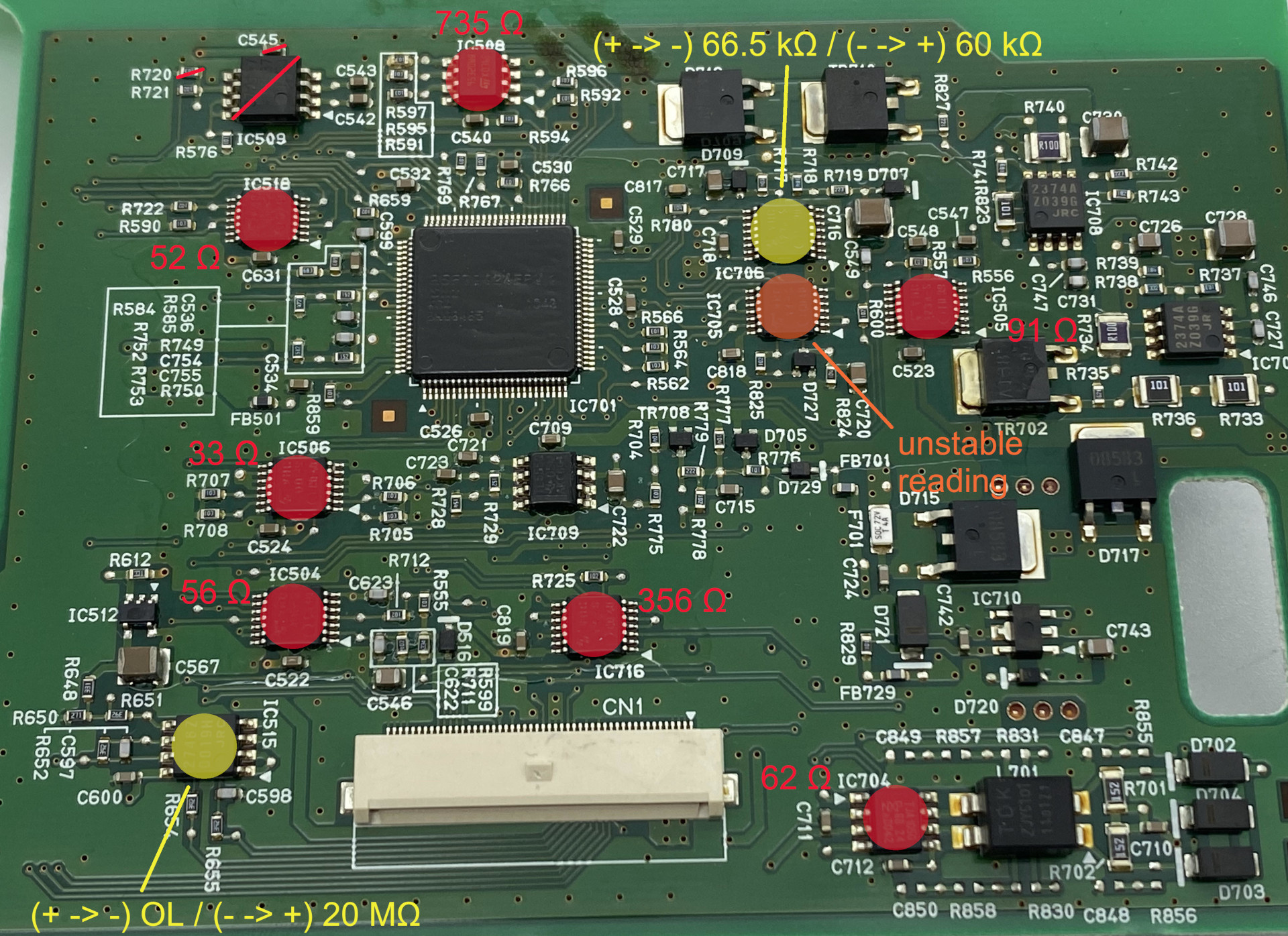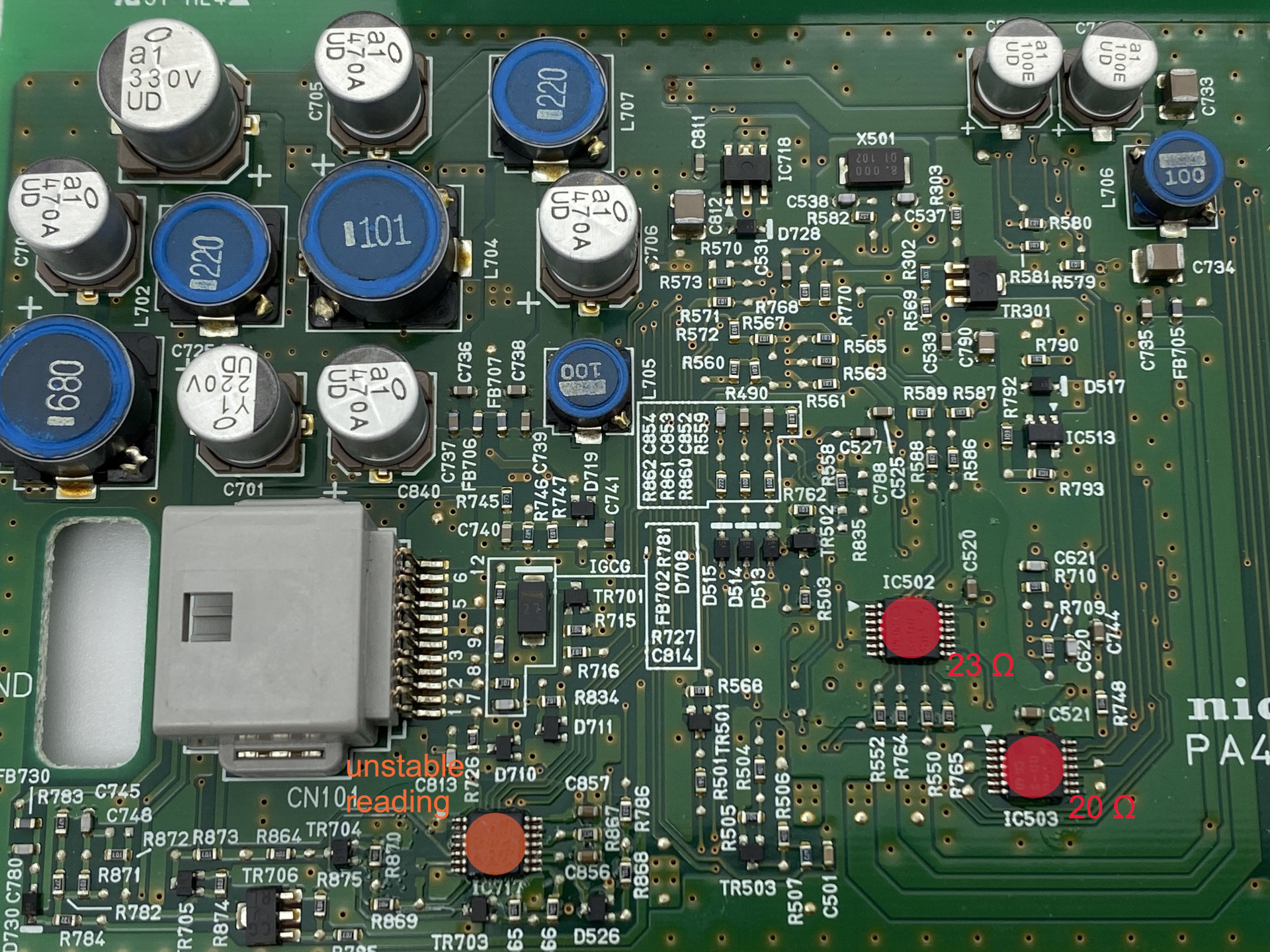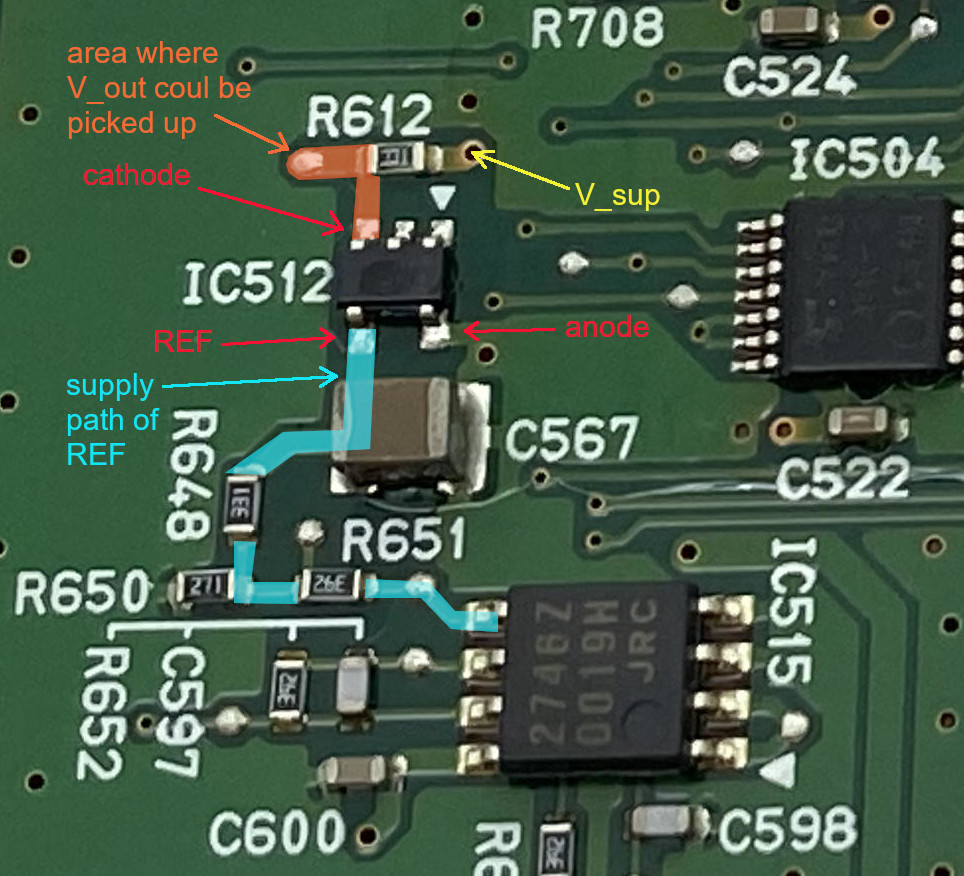iOnico
Member
OK, I went on with testing the ICs out of the category “others”:
After having disconnected all these ICs I’m now reading a resistance of 774 Ω from 5V to Ground and of 674 Ω when switching the leads.
The resistance ranking of the ICs so far is (in ascending order):
IC503: 20 Ω
IC502: 23 Ω
IC506: 33 Ω
IC518: 52 Ω
IC504: 56 Ω
IC704: 62 Ω
IC505: 91 Ω
IC716: 356 Ω
IC508: 735 Ω
IC706: 66.5 kΩ (or 60 kΩ when switching the leads)
IC515: OL (or 20 MΩ when switching the leads)
IC705 and IC717 are particular: they show a strange behaviour as reading won’t get stable: during minutes, measured resistance will grow by 1-3 unit steps of the smallest digit displayed (1-3 Ω when meter display is showing kΩs, 1-3 kΩ when meter diplay is showing MΩs). I stopped the measurement on IC705 after several minutes of watching the figure go up from around 1 MΩ to 2.3 MΩ (and from around 240 kΩ to 760 kΩ after having switched the leads) although the figures hadn’t settled. The growing reading is to observe independently of the sense of the measurement (leads switched or not) and on all reproduced measurements. The same is for IC717: no stable reading came out, resistance was at least 240 kΩ before starting growing. So, these chips won’t have participated to the short, but they are doing strange things. You may be surprised that these findings are not in line with what I had written in my last post: I realized when measuring today that on the measures taken last time, I had contact to the 5V circuit (my lead was touching the disconnected VCC contact of the IC but also the solder pad of the 5V supply from which it had been disconnected). The around 60 kΩ of resistance I had measured were between the 5V solder pad and Ground. I’m finding these same resistance values also when I’m touching with the leads the capacitors next to the VCC pins of IC717 (C857) or of IC705 (C818) and measure against Ground.
And the same information as readings included into the pictures:


I don’t want to be too optimistic, and some expert opinion will be very welcome to interpret these findings. The resistance values from 5V to Ground (and vice versa) are now higher than those that Kenny had measured on his boards. To me, this looks as if the devices creating the short have now been disconnected and the board could have not too bad chances to work correctly again if the devices having a resistance of less than 1kΩ (IC503-IC508 according to the order of the list above) would be replaced. I don’t know at all what I should think about IC705 and IC717. I don’t know if the observations made on them are part of a normal behaviour, if it’s a sign of damage of the ICs or if it could be a sign of even more trouble somewhere in the circuit around these two ICs.
This is too much of an open end for me so @kiev I’ll contact you via PM concerning the board you have. Would be great if this could be the solution!
Others:
74VHC123A, Multivibrator, IC#: 505,706 Vcc pin16
ST95320W, eeprom, IC#: 508 Vcc pin8
TJA1050, CAN Transceiver, IC#: 704 Vcc pin3
JRC2746, Dual OpAmp, IC#: 515 Vcc pin8
After having disconnected all these ICs I’m now reading a resistance of 774 Ω from 5V to Ground and of 674 Ω when switching the leads.
The resistance ranking of the ICs so far is (in ascending order):
IC503: 20 Ω
IC502: 23 Ω
IC506: 33 Ω
IC518: 52 Ω
IC504: 56 Ω
IC704: 62 Ω
IC505: 91 Ω
IC716: 356 Ω
IC508: 735 Ω
IC706: 66.5 kΩ (or 60 kΩ when switching the leads)
IC515: OL (or 20 MΩ when switching the leads)
IC705 and IC717 are particular: they show a strange behaviour as reading won’t get stable: during minutes, measured resistance will grow by 1-3 unit steps of the smallest digit displayed (1-3 Ω when meter display is showing kΩs, 1-3 kΩ when meter diplay is showing MΩs). I stopped the measurement on IC705 after several minutes of watching the figure go up from around 1 MΩ to 2.3 MΩ (and from around 240 kΩ to 760 kΩ after having switched the leads) although the figures hadn’t settled. The growing reading is to observe independently of the sense of the measurement (leads switched or not) and on all reproduced measurements. The same is for IC717: no stable reading came out, resistance was at least 240 kΩ before starting growing. So, these chips won’t have participated to the short, but they are doing strange things. You may be surprised that these findings are not in line with what I had written in my last post: I realized when measuring today that on the measures taken last time, I had contact to the 5V circuit (my lead was touching the disconnected VCC contact of the IC but also the solder pad of the 5V supply from which it had been disconnected). The around 60 kΩ of resistance I had measured were between the 5V solder pad and Ground. I’m finding these same resistance values also when I’m touching with the leads the capacitors next to the VCC pins of IC717 (C857) or of IC705 (C818) and measure against Ground.
And the same information as readings included into the pictures:


I don’t want to be too optimistic, and some expert opinion will be very welcome to interpret these findings. The resistance values from 5V to Ground (and vice versa) are now higher than those that Kenny had measured on his boards. To me, this looks as if the devices creating the short have now been disconnected and the board could have not too bad chances to work correctly again if the devices having a resistance of less than 1kΩ (IC503-IC508 according to the order of the list above) would be replaced. I don’t know at all what I should think about IC705 and IC717. I don’t know if the observations made on them are part of a normal behaviour, if it’s a sign of damage of the ICs or if it could be a sign of even more trouble somewhere in the circuit around these two ICs.
This is too much of an open end for me so @kiev I’ll contact you via PM concerning the board you have. Would be great if this could be the solution!


































